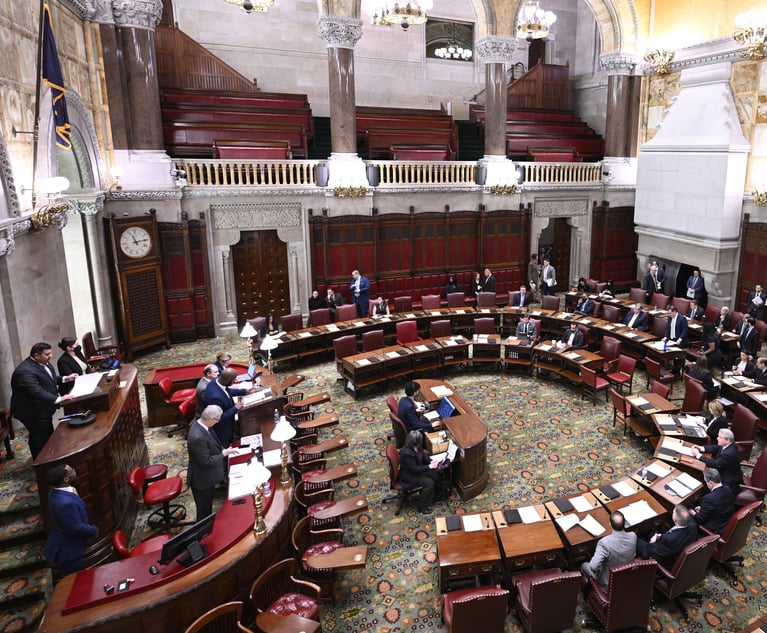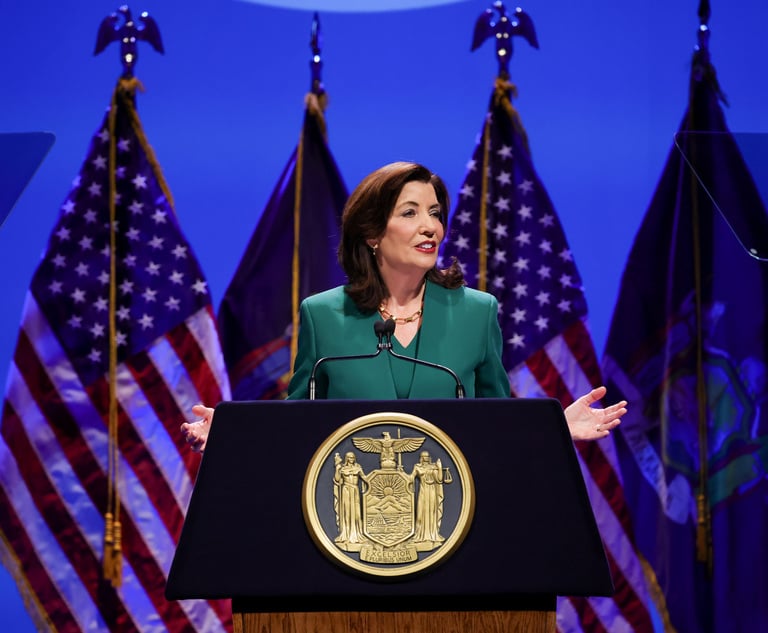Attorneys Optimistic as NY Courts Eye Commercial Division Videoconferencing
While the new rule would open the door to video appearances, it would not require remote participation, and individual justices would retain discretion in deciding whether to grant the requests.
August 07, 2019 at 05:51 PM
4 minute read
 Photo: suriyachan/Shutterstock.com
Photo: suriyachan/Shutterstock.com
A proposed rule to allow the use of videoconferencing for some Commercial Division proceedings could make life a lot easier for attorneys and their clients, lawyers said this week.
The Administrative Board of the Courts announced Aug. 1 that it is seeking public comment on the proposal from the Commercial Division Advisory Council, which would permit attorneys to ask the court’s permission to participate in conferences and oral arguments from afar, using videoconferencing or other technologies.
While the new rule would open the door to video appearances, it would not require remote participation, and individual justices would retain discretion in deciding whether to grant the requests.
“It’s certainly going to make a lot of lawyers happy,” said Helene Hechtkopf, a partner with Hoguet Newman Regal & Kenney in Manhattan.
In a memorandum dated July 12, the advisory council said that implementing a videoconferencing option would enhance court efficiency and cut down on expenses for attorneys who have to travel long distances to appear in court.
“The case for making greater use of this simple yet effective technology is obvious and compelling, and it presents an opportunity for the Commercial Division to continue its innovation and leadership in the smart adoption of technology in aid of the efficient administration of justice,” the memo read.
Hechtkopf said the proposed rule would also favor clients, who can be billed for the time attorneys spend traveling and waiting in court for their turn to argue motions.
“Streamlining that process is only going to benefit the client,” she said. “It’s certainly a nice option to have.”
Attorneys agreed that it is often important to appear personally in court, where they are better able to gauge a judge’s reactions to their arguments and respond to overbearing or inappropriate behavior by opposing counsel.
But Scott Musoff, head of Skadden, Arps, Slate, Meagher & Flom’s New York litigation practice, said the rule would add a new level of flexibility for attorneys and judges, “which is important because there are certainly some motions or conferences where it is necessary to be there in person.”
“The way it’s fashioned seems to be promoting efficiency but maintaining discretion as to when it is to be used,” he said.
Scott Mollen, a member of the advisory council who said he was authorized to discuss the proposal, said many firms were already using videoconferencing, and the costs to implementing the feature would be low.
In addition, the advisory council noted that at least five federal appeals courts, including the U.S. Court of Appeals for the Second Circuit, have used some form of videoconferencing technology in conducting oral arguments, and state and federal trial courts in recent years have followed suit.
For the Commercial Division, which draws litigants from across the globe, the technology would also be a major selling point, as it competes with other jurisdictions to attract commercial cases.
“Clients in other states and other countries [may] be more receptive to New York as a venue if they can observe the proceedings without the need to incur expensive airplane and hotel costs,” Mollen said.
Musoff agreed that the use of videoconferencing “can enhance the attractiveness of the court to litigants who are not located in New York,” but said the proposal “primarily goes to the Commercial Division’s goal of promoting quick and efficient resolutions to matters.”
It remains to be seen how the rule would be implemented in the courtroom, but it was clear that the ultimate decision-making power would be left to individual judges.
“Some of it’s going to have to be wait-and-see,” Musoff said. “I think you’re going to see justices experimenting with it.”
The Administrative Board of the Courts is accepting public comment on the proposal until Sept. 30. Submissions can be emailed to [email protected] or sent by mail to John W. McConnell of the Office of Court Administration at 25 Beaver St., 11th FI., New York, New York, 10004.
Read More:
In an Effort to Be the Premier Court in the World, NY Is Investing in the Commercial Division
The Importance of Technology in a Growing Law Firm
Technology Is a Solo Attorney’s Silent Partner
This content has been archived. It is available through our partners, LexisNexis® and Bloomberg Law.
To view this content, please continue to their sites.
Not a Lexis Subscriber?
Subscribe Now
Not a Bloomberg Law Subscriber?
Subscribe Now
NOT FOR REPRINT
© 2025 ALM Global, LLC, All Rights Reserved. Request academic re-use from www.copyright.com. All other uses, submit a request to [email protected]. For more information visit Asset & Logo Licensing.
You Might Like
View All

Federal Judge Pauses Trump Funding Freeze as Democratic AGs Plan Suit
4 minute read
Relaxing Penalties on Discovery Noncompliance Allows Criminal Cases to Get Decided on Merit
5 minute read
Bipartisan Lawmakers to Hochul Urge Greater Student Loan Forgiveness for Public-Interest Lawyers
Trending Stories
- 1An Eye on ‘De-Risking’: Chewing on Hot Topics in Litigation Funding With Jeffery Lula of GLS Capital
- 2Arguing Class Actions: With Friends Like These...
- 3How Some Elite Law Firms Are Growing Equity Partner Ranks Faster Than Others
- 4Fried Frank Partner Leaves for Paul Hastings to Start Tech Transactions Practice
- 5Stradley Ronon Welcomes Insurance Team From Mintz
Who Got The Work
J. Brugh Lower of Gibbons has entered an appearance for industrial equipment supplier Devco Corporation in a pending trademark infringement lawsuit. The suit, accusing the defendant of selling knock-off Graco products, was filed Dec. 18 in New Jersey District Court by Rivkin Radler on behalf of Graco Inc. and Graco Minnesota. The case, assigned to U.S. District Judge Zahid N. Quraishi, is 3:24-cv-11294, Graco Inc. et al v. Devco Corporation.
Who Got The Work
Rebecca Maller-Stein and Kent A. Yalowitz of Arnold & Porter Kaye Scholer have entered their appearances for Hanaco Venture Capital and its executives, Lior Prosor and David Frankel, in a pending securities lawsuit. The action, filed on Dec. 24 in New York Southern District Court by Zell, Aron & Co. on behalf of Goldeneye Advisors, accuses the defendants of negligently and fraudulently managing the plaintiff's $1 million investment. The case, assigned to U.S. District Judge Vernon S. Broderick, is 1:24-cv-09918, Goldeneye Advisors, LLC v. Hanaco Venture Capital, Ltd. et al.
Who Got The Work
Attorneys from A&O Shearman has stepped in as defense counsel for Toronto-Dominion Bank and other defendants in a pending securities class action. The suit, filed Dec. 11 in New York Southern District Court by Bleichmar Fonti & Auld, accuses the defendants of concealing the bank's 'pervasive' deficiencies in regards to its compliance with the Bank Secrecy Act and the quality of its anti-money laundering controls. The case, assigned to U.S. District Judge Arun Subramanian, is 1:24-cv-09445, Gonzalez v. The Toronto-Dominion Bank et al.
Who Got The Work
Crown Castle International, a Pennsylvania company providing shared communications infrastructure, has turned to Luke D. Wolf of Gordon Rees Scully Mansukhani to fend off a pending breach-of-contract lawsuit. The court action, filed Nov. 25 in Michigan Eastern District Court by Hooper Hathaway PC on behalf of The Town Residences LLC, accuses Crown Castle of failing to transfer approximately $30,000 in utility payments from T-Mobile in breach of a roof-top lease and assignment agreement. The case, assigned to U.S. District Judge Susan K. Declercq, is 2:24-cv-13131, The Town Residences LLC v. T-Mobile US, Inc. et al.
Who Got The Work
Wilfred P. Coronato and Daniel M. Schwartz of McCarter & English have stepped in as defense counsel to Electrolux Home Products Inc. in a pending product liability lawsuit. The court action, filed Nov. 26 in New York Eastern District Court by Poulos Lopiccolo PC and Nagel Rice LLP on behalf of David Stern, alleges that the defendant's refrigerators’ drawers and shelving repeatedly break and fall apart within months after purchase. The case, assigned to U.S. District Judge Joan M. Azrack, is 2:24-cv-08204, Stern v. Electrolux Home Products, Inc.
Featured Firms
Law Offices of Gary Martin Hays & Associates, P.C.
(470) 294-1674
Law Offices of Mark E. Salomone
(857) 444-6468
Smith & Hassler
(713) 739-1250






